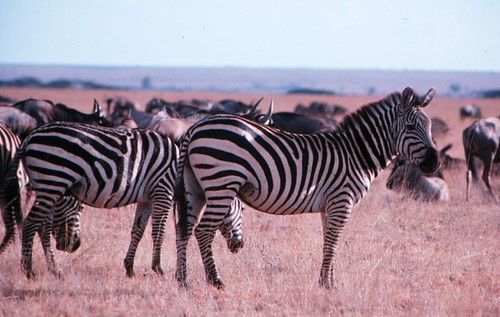Maasai pastoral herders signing up to the Naboisho Conservancy in Mara area in 2010. Ecosystem conservation schemes are giving herders new sources of income (photo credit: ILRI/Bedelian).
Biodiversity conservation among pastoral communities is increasingly researched as an area that could hold the key to helping pastoralists deal with the challenges of climate change and land use policy changes by allowing them to diversify their incomes. In Kenya the use of payments for ecosystem services, mostly around the country’s reserves and parks—where people live close to wildlife—is providing a stable, reliable and predicable source of income to pastoralists with the double advantage of reducing poverty and protecting wildlife.
In many sites where payments for ecosystem services have be piloted successfully, local-level institutions have played a significant role in enabling communities to self-govern and are supported by flexible land-use and governance systems that respect the communal land ownership patterns that have traditionally existed in these areas.
Payments to livestock herders for the ecosystem services generated through their land uses are currently being made in lands adjacent to Kenya’s famous Masai Mara National Reserve, in the southwest of the country, and in the Kitengela wildlife dispersal area to the south of Nairobi National Park. In both areas, Maasai people have formed ‘eco-conservancies’ to protect their grazing areas for livestock and wildlife alike.
‘Findings from on-going research show that in 2009 in the Kitengela area, ecosystems payment schemes were providing a large amount of income that constituted 59 per cent of the total off-farm earnings among participating households, even though livestock keeping is still the largest and most important source of income for these pastoralists,’ said Philip Osano a student at McGill University who is affiliated to the International Livestock Research Institute (ILRI) and is evaluating the effects of payments for ecosystems services on poverty reduction among pastoral communities in Kenyan rangelands.
‘Even though income from conservation payments is proving a valuable buffer against shocks such as tourism unpredictability and drought, creation of ‘eco-conservancies’ has displaced people and introduced new restrictions to grazing, natural resource collection and movement, increasing pressure on land in areas that border the eco-conservancies,’ says Claire Bedelian, a University College London researcher at ILRI who is accessing the impact of conservancy land leases on Maasai pastoralists in areas adjacent to the Masai Mara National Reserve
Scientists at ILRI, headquartered in Nairobi, Kenya, are investigating these hard trade offs to ensure that the benefits of such interventions are more equitable among members of the pastoral communities inhabiting these wildlife-rich areas.




